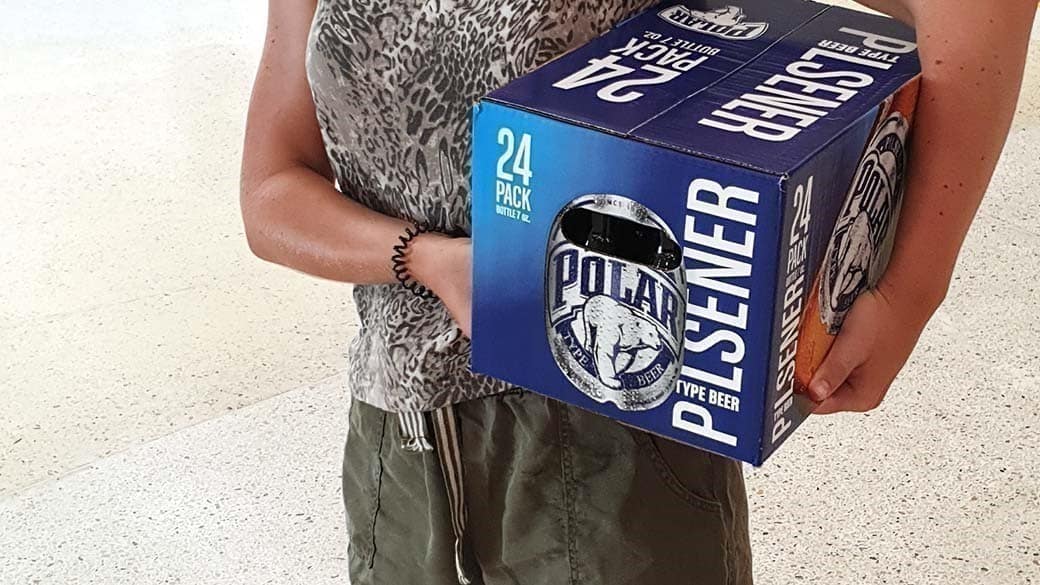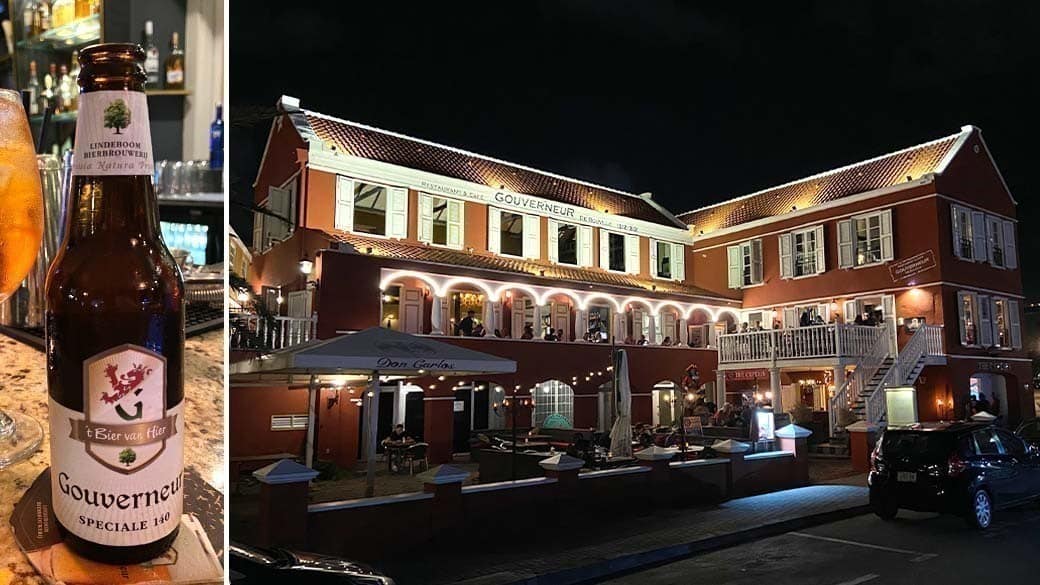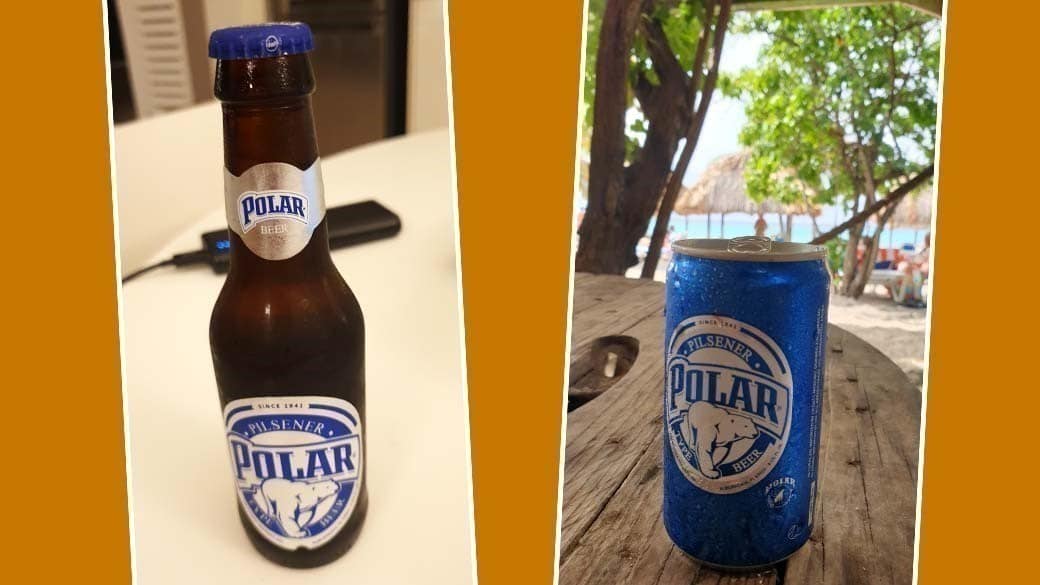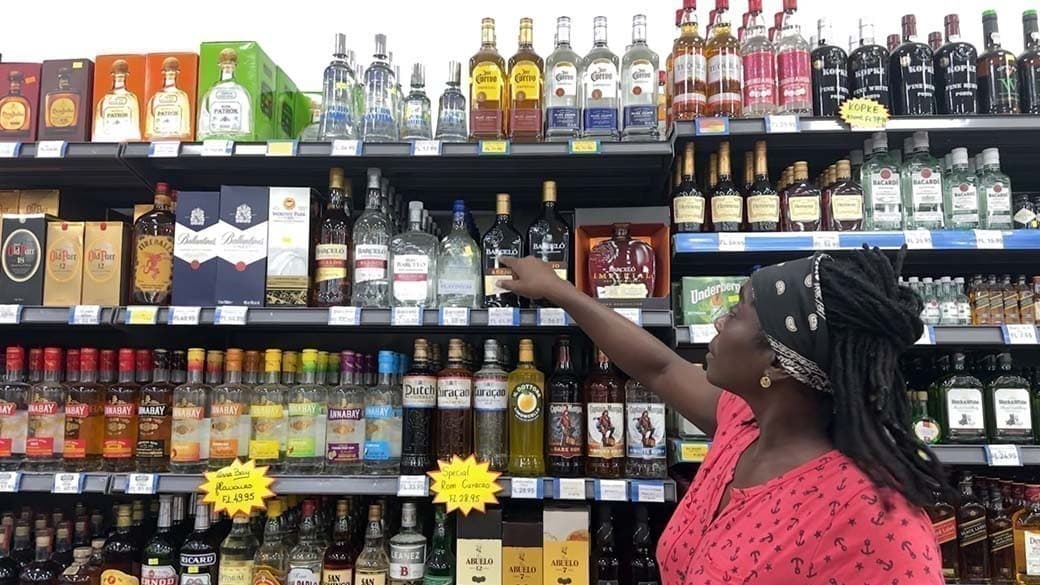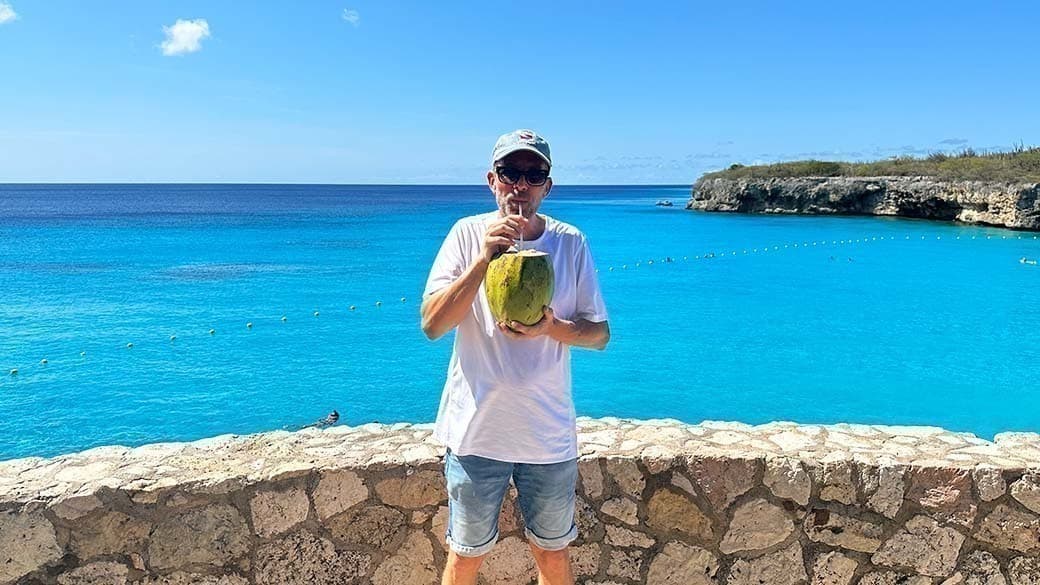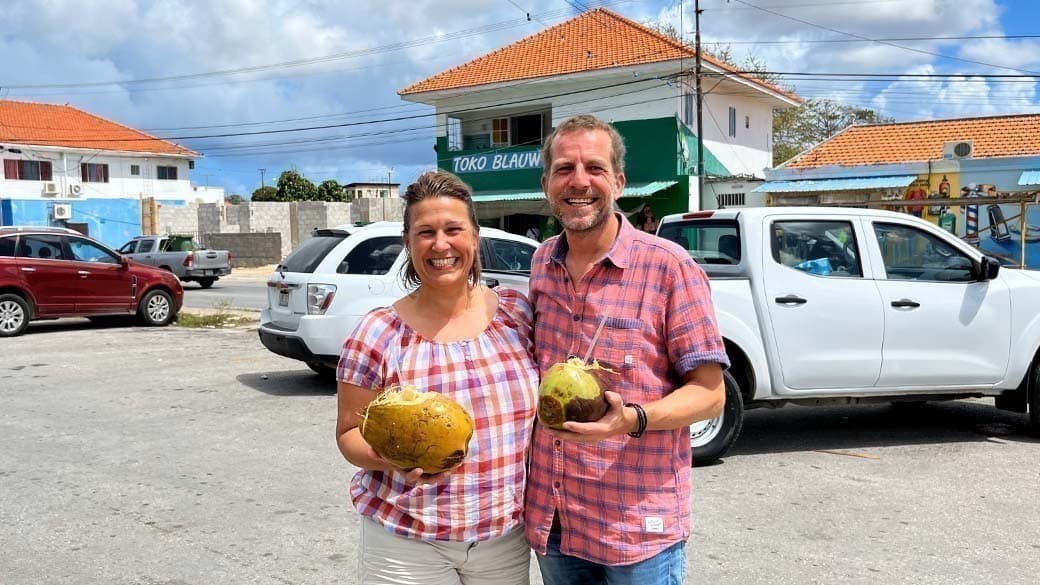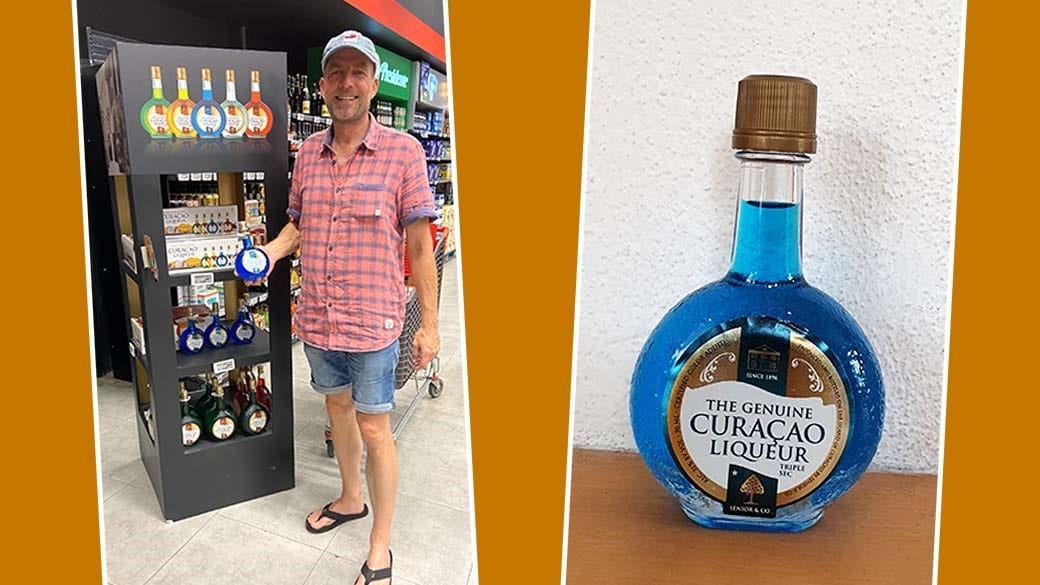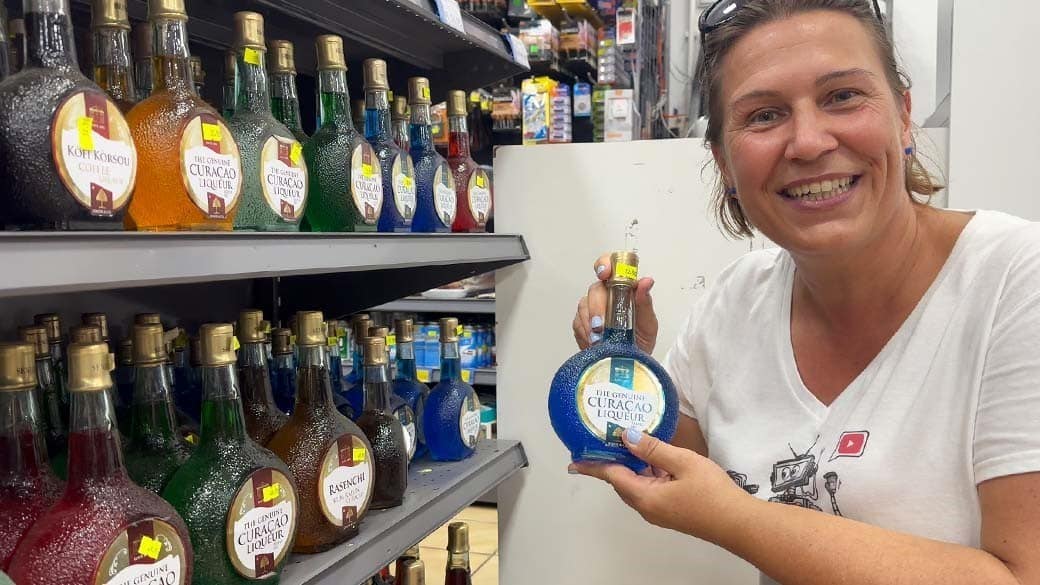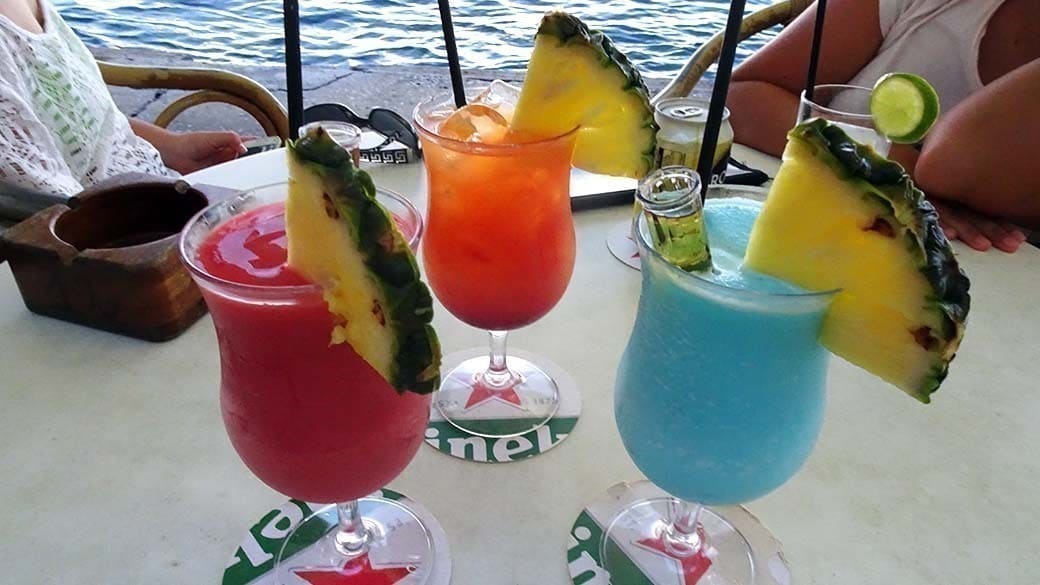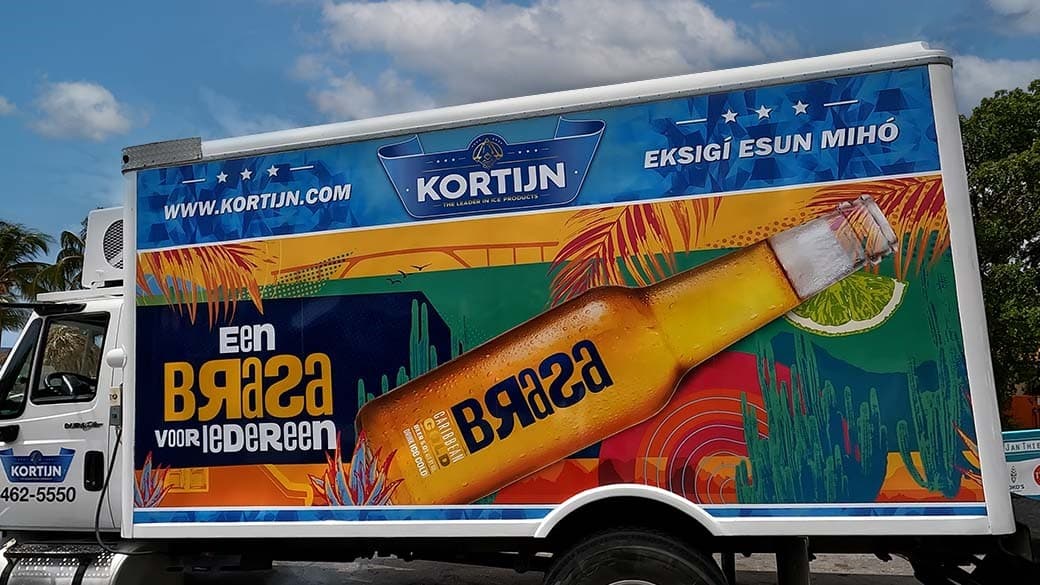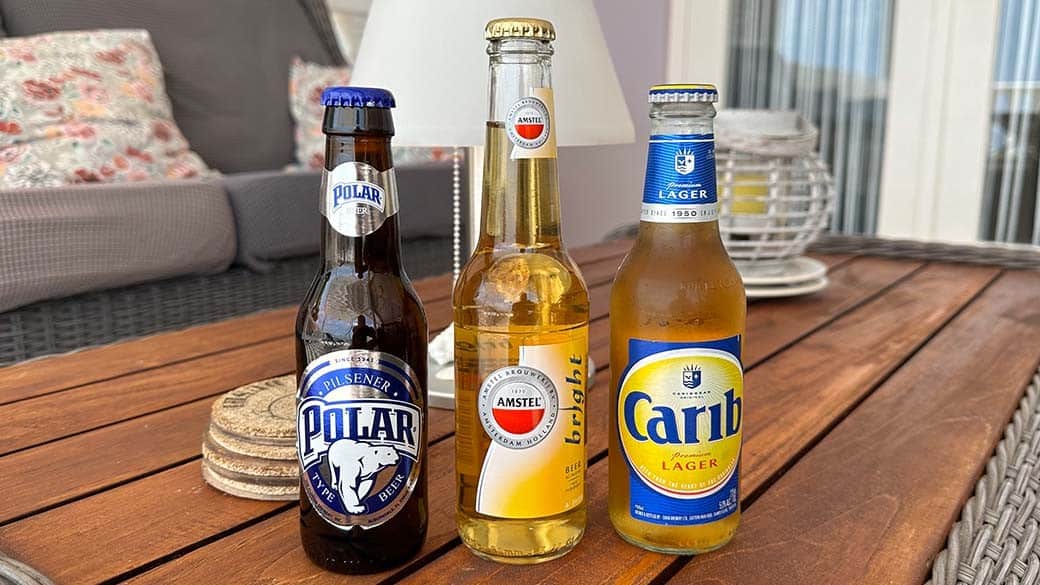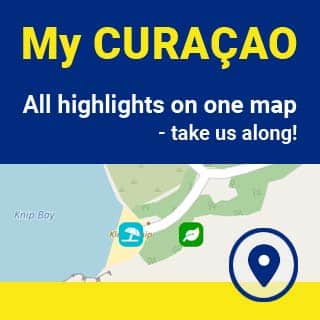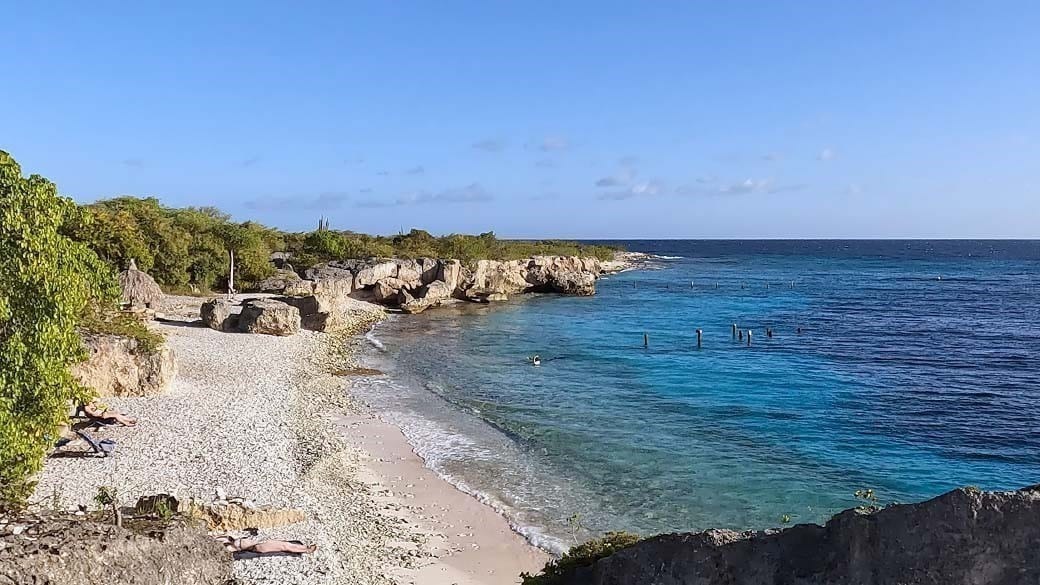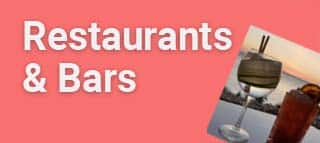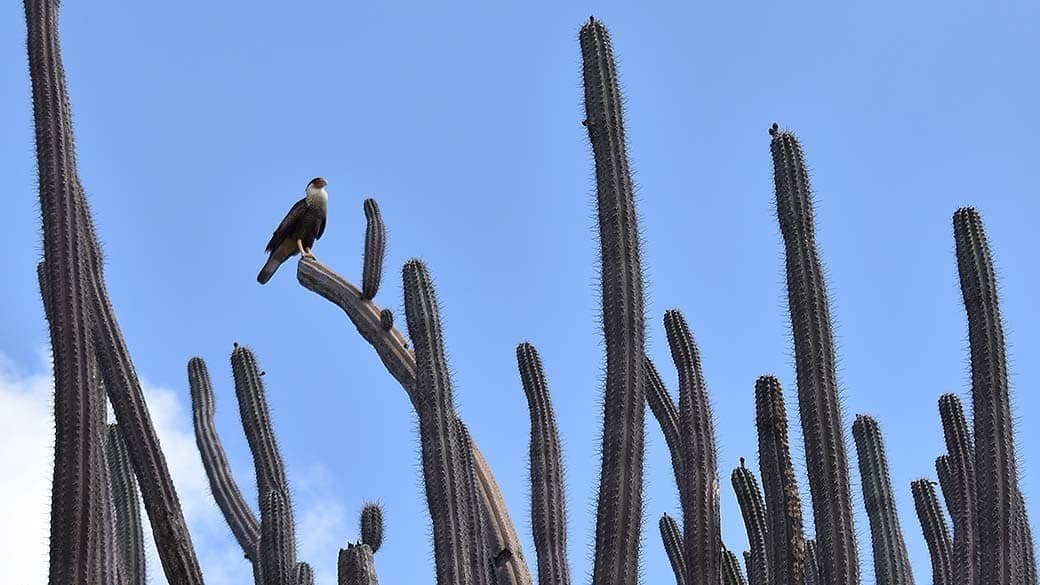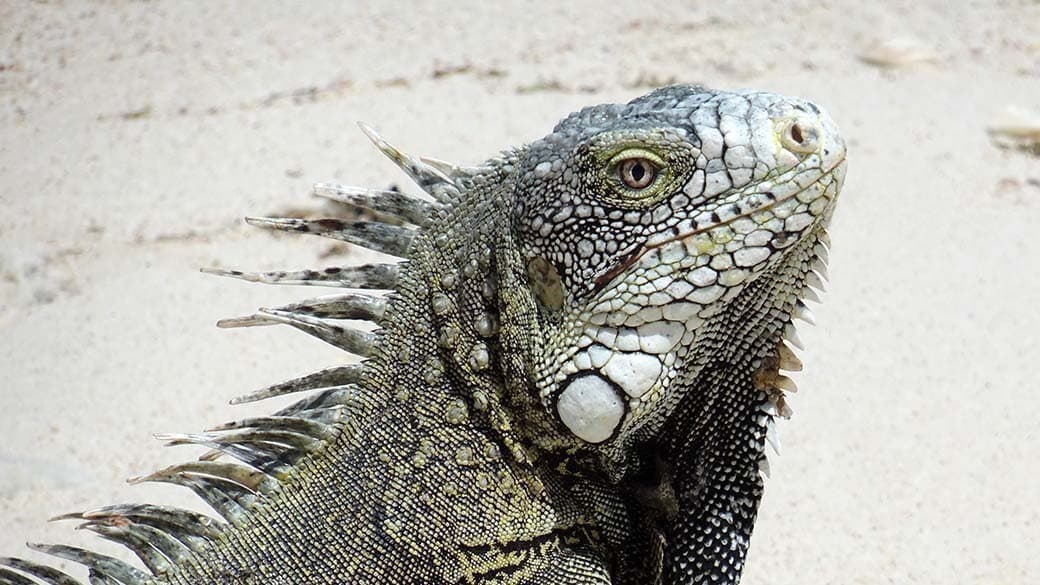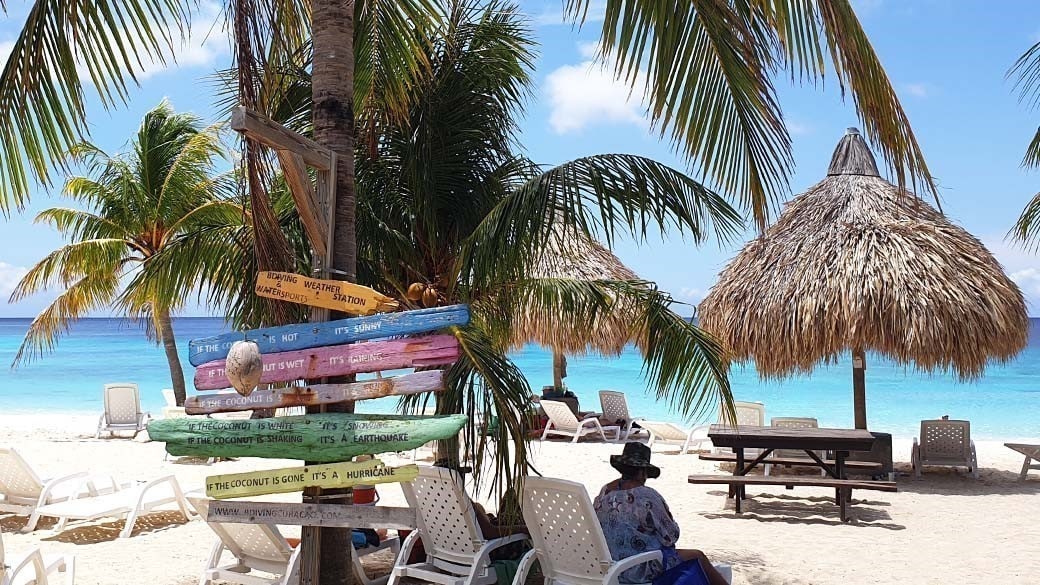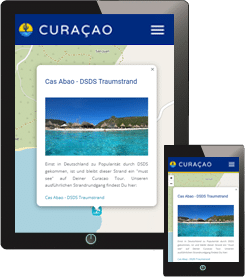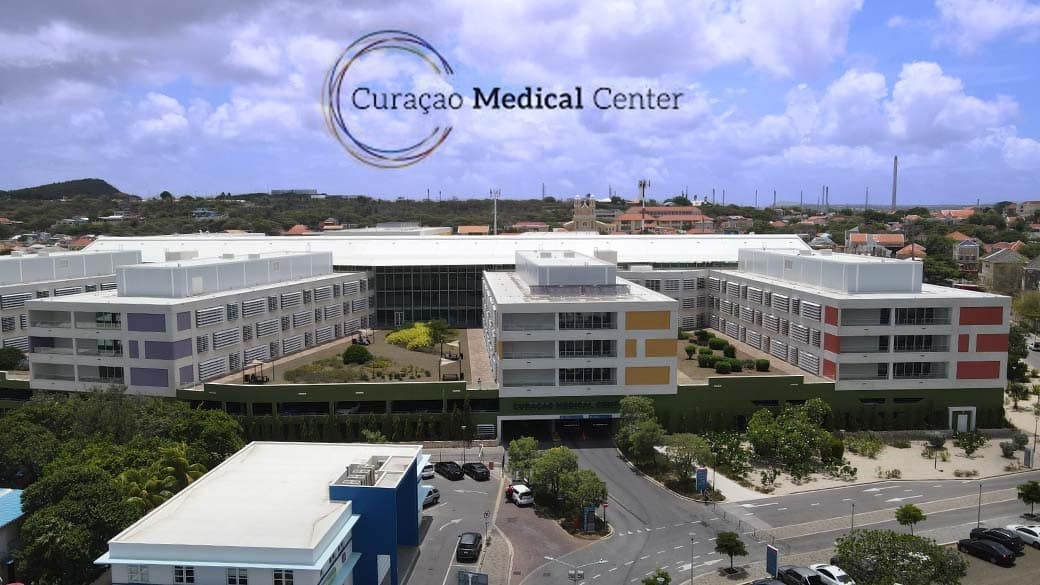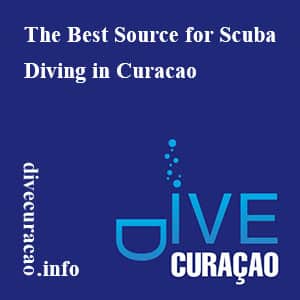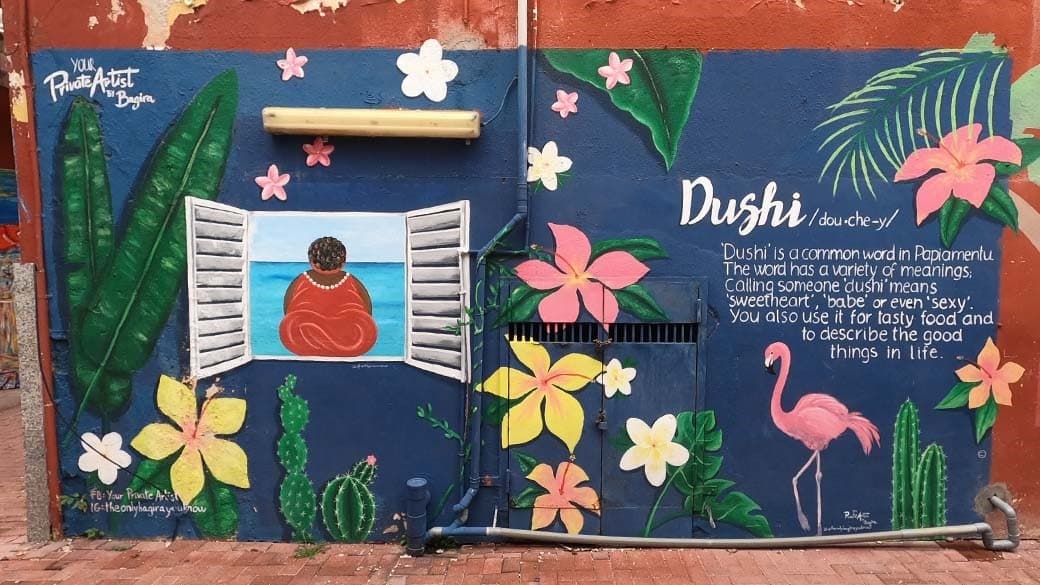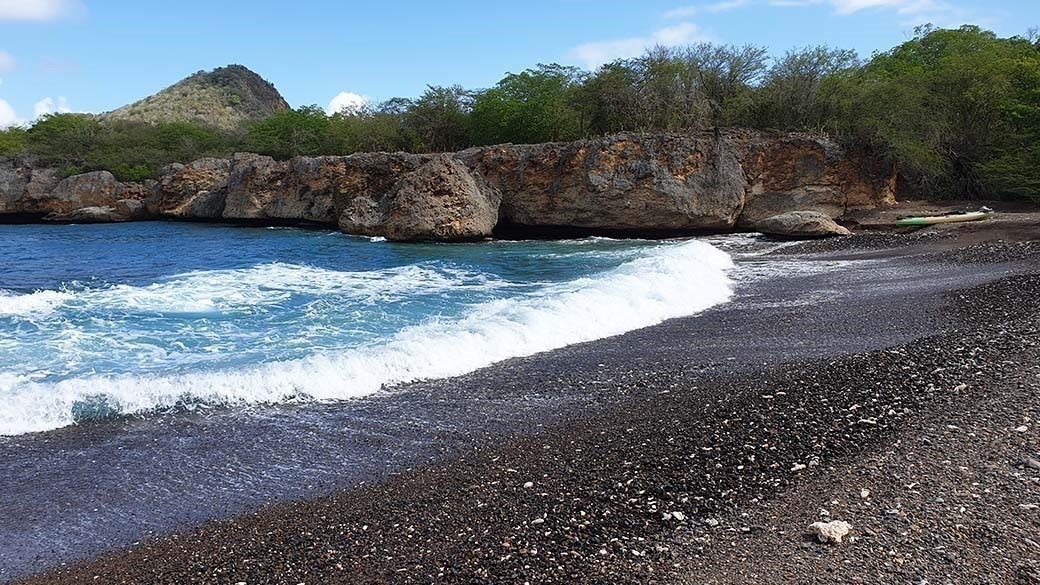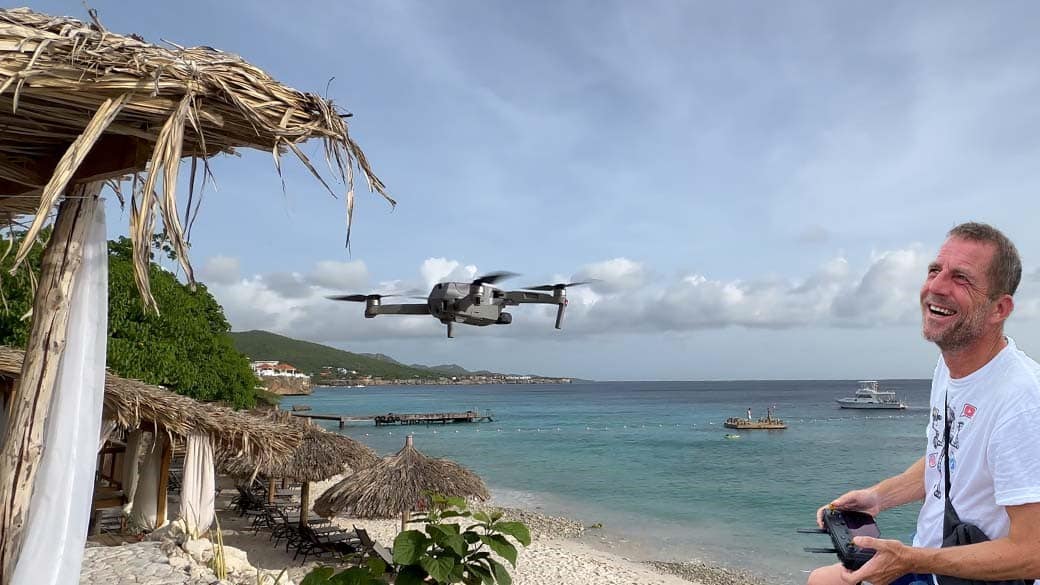The national drink of Curacao
Mix and match to refresh

What’s the national drink of Curaçao? What’s the most popular? What’s the drink that’s consumed the most? Which drink best represents the island? Let’s find out together! Here are our experiences so far:
Candidate number 1 Blue Curacao
Blue Curacao represents the island worldwide like no other drink. Although the orange liqueur is mixed with blue food coloring, the Caribbean Sea on many beaches, such as the Grote Knip, has exactly the same color (see cover collage).
Blue Curacao is probably even more well-known than the island itself. At Relaxed Curacao, we’re doing our part to make sure it doesn’t stay that way.
Blue Curacao is often used in cocktails like the Swimming Pool or the Blue Lagoon. In my opinion, it’s better to mix it. I’ve tried a red Curacao liqueur. Why red? Just read our separate article on Blue Curacao. Anyway, Taco from the Cactus Café served it to me neat in a tumbler. It was a bit like drinking whiskey or cognac, because I could feel the high-proof power from the very first sip.
The people of Curacao are proud that the only true, original Blue Curacao comes from their homeland. Aldrich Hermelijn, who is a child of the island, recommends it as a souvenir. He thinks that everyone who visits Curacao should take one with them so they can say:
“Hey, this kind of liqueur is available everywhere, but I have the original.”
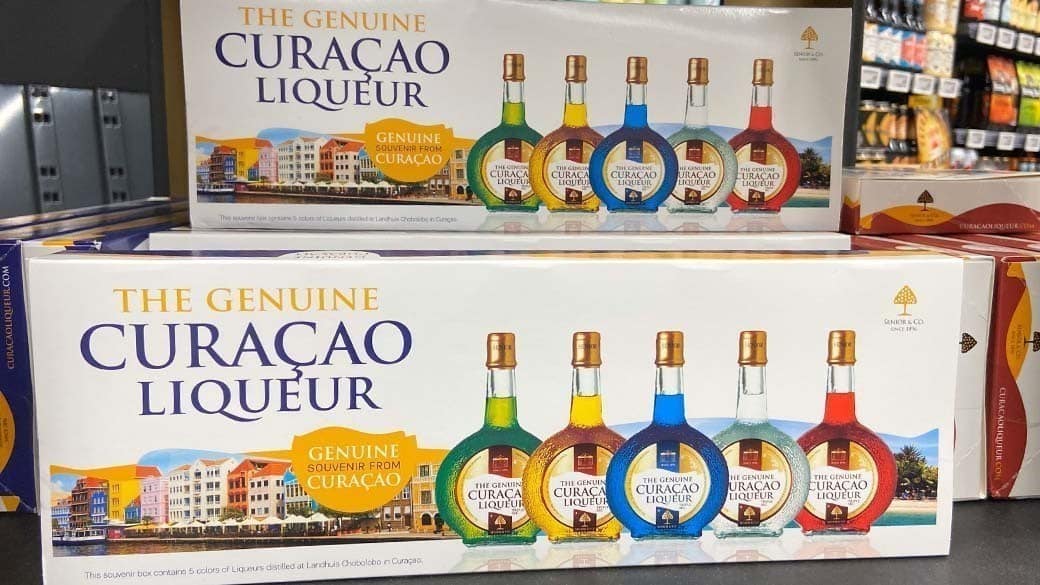
The miniatures of Senior Curacao liqueurs are a popular souvenir
We wouldn’t call Blue Curacao “the national drink”. Not everyone can afford it (375 ml is just under 17 euros) and not everyone likes the taste.
The search for the national drink of Curacao goes on
As members of generation Golf, we like to drink rum and coke – also known as Cuba Libre. And since rum is an export hit from the Caribbean, we are more or less at the source in Curacao – even though sugar cane doesn’t grow on the island itself. Interestingly, stores and bars have many different types of rum on offer. The spirits are sold separately at a counter in most supermarkets. You’ll find beer, sparkling wine, and wine on the shelves as usual.
Stefan treated himself to a rum tasting one evening at Bario. He tried varieties he’d never heard of, even though he used to work at the bar in his youth. The local rums are often flavored with vanilla. We prefer the Dominican Ron Barcelo, which we can also buy on Curacao, with a wedge of lime in it.
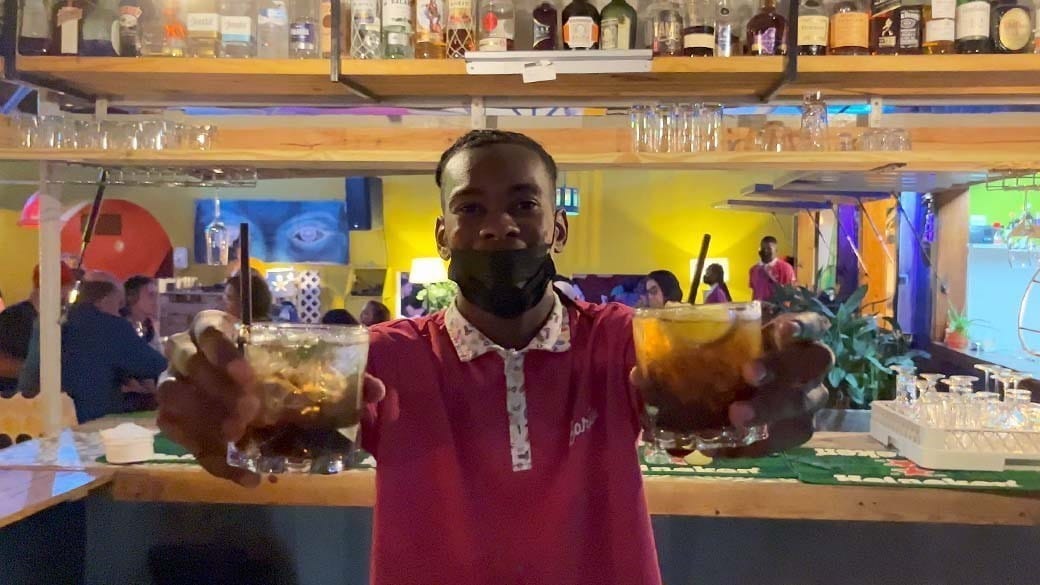
Cuba libres in Bario
Green rum from Curacao
Ròm Bèrdè, as the green rum is called on Papiamentu, is only available in Curacao. The best place to drink it is in the Nettobar in Otrobanda. Ernesto “Netto” Koster invented this special rum. The recipe is probably top secret, so we’ll never know what makes it so green and what makes it tast so different. Our friend Susanne, manager of Whitehouse Lagun, who has already drunk it, says that Ròm Bèrdè tastes best with fresh coconut water “on the rocks”.
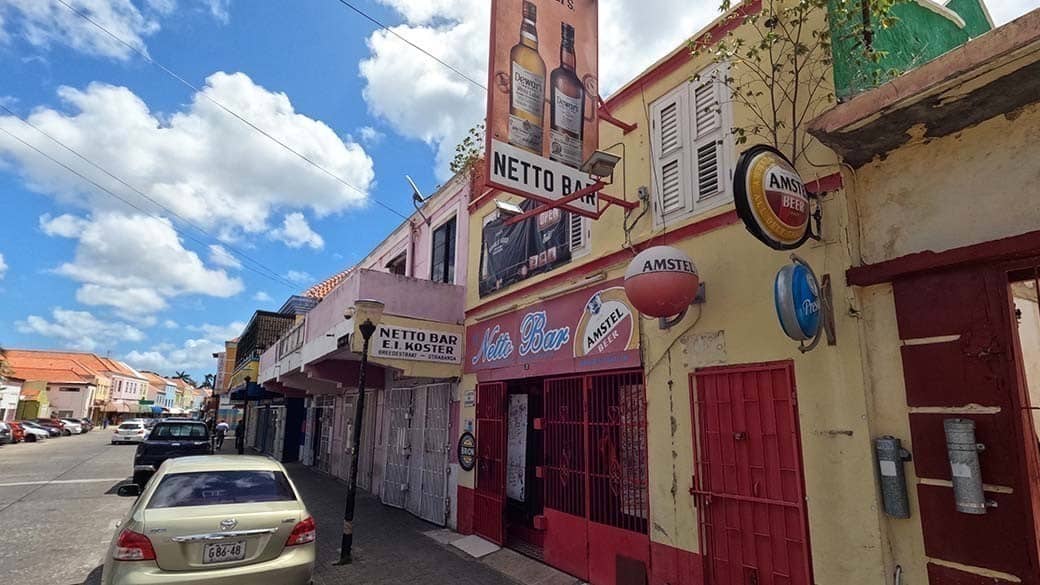
The famous Netto Bar in the Breedestraat
While exploring Otrobanda, we passed the Netto Bar. Unfortunately, it was closed, so we couldn’t try it. Later, we came across some green rum in a store, which also comes from Curacao but isn’t the one from the Netto Bar. Since then, it’s been sitting on our bar like a memorial. Somehow we haven’t had a good reason to open the bottle yet.
Ròm Bèrdè is a local specialty, but it’s so distinctive that it probably doesn’t have what it takes to be a national drink.
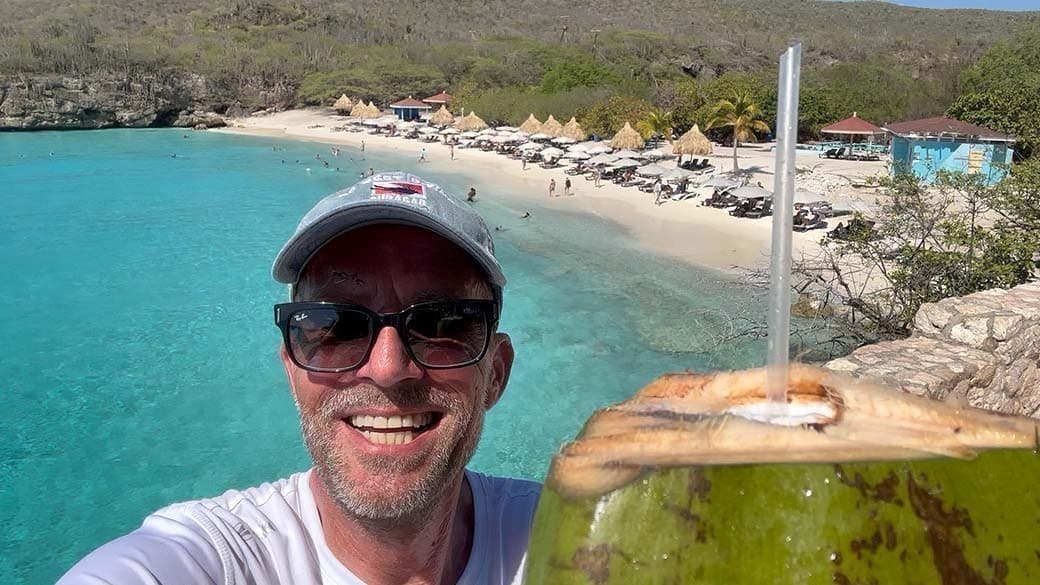
Coconut drink at Kenepa Grandi at 36°
Coco frio
You’ll find chilled coconut, called coco frio here, on every street corner on Curacao. Lots of people, including locals, regularly stop to get this refreshing drink. Its preparation is quite a show: The coconut is freshly opened and carved for you with a machete or cleaver. You drink the coconut water straight from the nut. Simply insert a straw and enjoy.
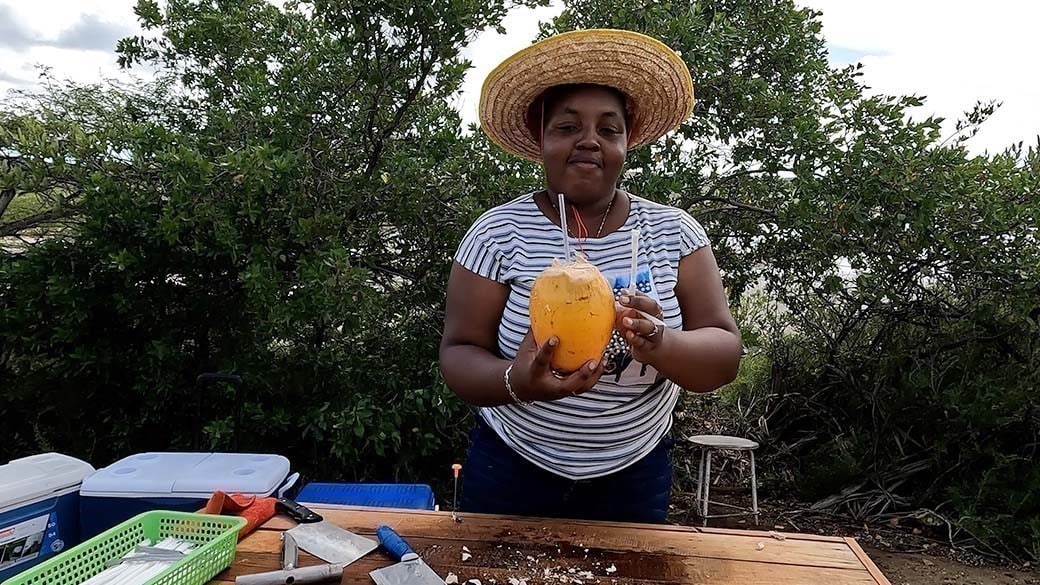
Street vending at Jan Kok
Although I do drink it sometimes, coconut water is not one of my favorite drinks. Stefan quite likes it iced. That’s where we differ in our opinions.
So what about coco frio as a national drink?
Coconuts aren’t native to Curaçao. But you’ll find coconut palms everywhere on the island. Coconuts wash up from Venezuela all the time and still grow well. Cacti like the Kadushi cactus are typical native plants on Curaçao. They’re better at dealing with the dry climate.
That’s why I think the coconut should be eliminated from the race for Curacao’s national drink.

This seller is fighting really hard for the title with Curacao’s national flag
Batidos
You only know Batida de Coco? Batidos are basically just shakes. At least that’s what they used to be called, but nowadays we use the trendier term: smoothies.
There are numerous smoothie stands and trucks on Curacao that offer them in all kinds of flavors – alcohol-free, of course. The list of pureed fruits is long, including mango, papaya, pineapple and banana. Guava and tamarind are less well-known here, but they’re really popular in Curacao. With the hot temperatures, it’s important to stay hydrated and avoid hypoglycemia. A vitamin and sugar boost like this cools you down and quickly makes you fit again.

Batido’s definitely have national drink potential
Beer means beer
Probably the most popular drink for adults on the beaches is and remains beer. At least that’s our observation. Or is it because it has the same name in Papiamentu, Dutch, and German, and is so easy to order?
Based on the huge selection in the supermarkets, we assume that beer sells like hot cakes. When we look at other people’s purchases, we almost always see beer. You can get Dutch, South American and local beers on Curacao, such as Montana, whose brewery you can visit in Landhuis Granbeeuw.
Unfortunately, I’m not much of a beer drinker, and I don’t drink it at home that often. When I do, it’s usually a shandy. But Curacao is almost my favorite place to drink it. In our experience, the most common varieties that you can get in almost all bars and restaurants are Polar and Amstel bright. While Stefan really likes Polar, I prefer Amstel bright. I like the pale, lighter beers such as Carib, Zulia and Brasa. They’re tangy like Pilsner, but not quite as bitter.
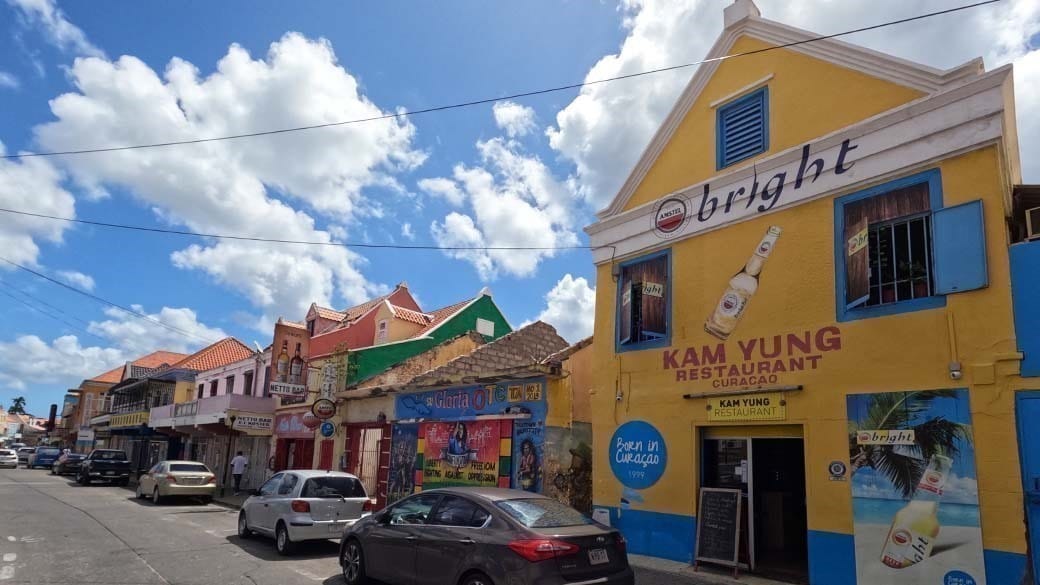
Inventive beer facade
On our walk through Otrobanda, we passed an Amstel bright-colored house on Breedestraat. I absolutely had to take a photo of it. The cult surrounding this beer brand continues at Mambo Beach. I was delighted to discover an Amstel bright surfboard there. Not far from there, I found a life-size pirate next to a Polar surfboard.
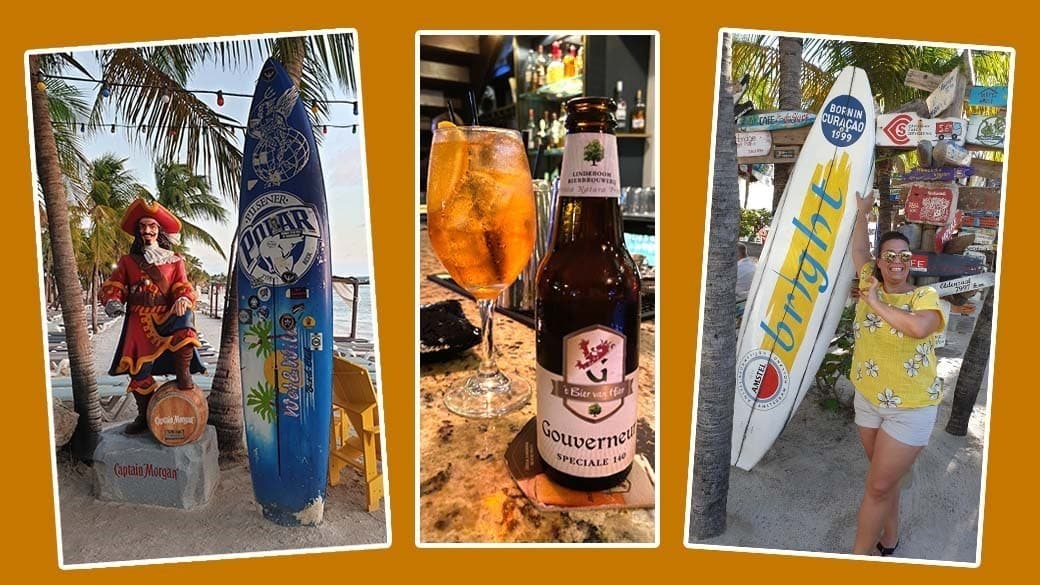
Surfin’ Curacao with Captain Morgan
The Governor has his own beer label…
… and even offers different kinds. The restaurant, Gouverneur, is right next to the ferry dock in Otrobanda. From the restaurant’s balcony, you can see the Handelskade and the Queen Emma Bridge. Over a good meal and a house beer, you can watch everything that’s going on in St. Anne’s Bay between Otrobanda and Punda. As a result, there are rarely any last-minute openings, so we suggest you book in advance.
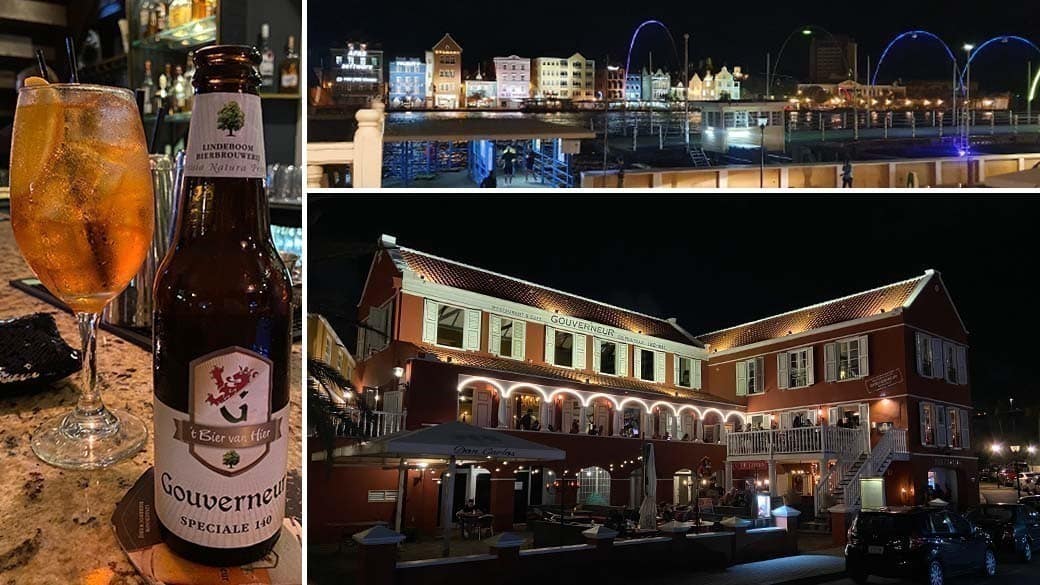
The Governor’s pictures make you want more, don’t they?
Our friend Bryan Horne thinks that beer is the most popular (alcoholic) drink on Curacao. Could this be the national drink of Curacao here? Not quite. Beer is the national drink of Bavaria, after all. We’re not taking any chances on that. 😉
The winner with the title “National Drink of Curacao”
After visiting Curacao several times, we think Awa di Lamunchi is the best bet for the national drink. What is it? Awa di Lamunchi is basically lime water. Everyone knows it, everyone drinks it. It’s a local specialty that’s refreshing and non-alcoholic, so it’s suitable for all age groups. Depending on your taste, you can choose between sparkling or still. We’ve dedicated a separate article to the Lamunchi, including a video, to give the recognition it deserves. Congratulations!
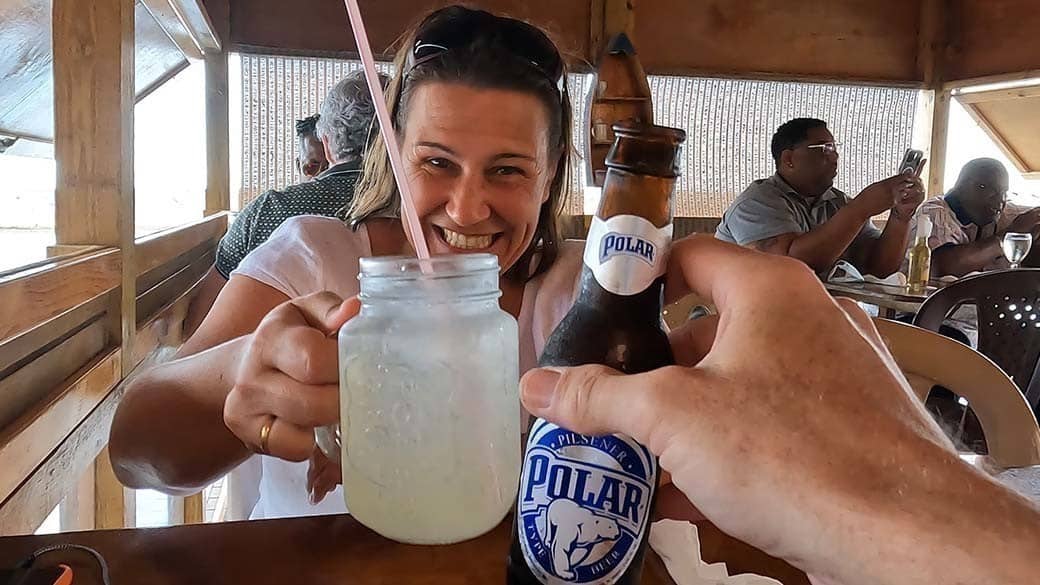
Cheers! To the winner!
Your input
We keep asking local people about the national drink of Curacao, but it’s still a matter of taste.
What experiences have you had? Which drink do you think is the national drink of Curacao? And why do you think so? We look forward to your comments!
Note from the editors
Just to be clear, the naming of brands of the various drinks in the article is not an advertisement for them. We are independent. We also take the protection of minors seriously and do not wish to encourage the consumption of alcoholic beverages by mentioning or depicting them. We’d like to avoid any misunderstandings about the content of this article.
Test your knowledge: We have prepared several hundred questions about Curacao. Have fun!
Quiz Question
Who is the "Swinging Old Lady"?Answer
This refers to the Queen Emma Bridge in Willemstad, the swinging old lady.
The Koningin Emmabrug, Pontjesbrug or Queen Emma Bridge is a floating pontoon bridge made of wood and steel that is over 100 years old. It connects the two districts of Punda and Otrobanda.
It is just under 10 meters wide and 167 meters long and can be completely moved to the Otrobanda shore side for ships to pass.
Do you like more? Here is another post you might be interested in:
If you enjoyed this article, we would be very happy if you share it with your friends on social media. Thank you very much!
Curacao’s underwater world is just as colorful as its lifestyle! Snorkel over and dive right in! On land, we are sure to inspire you with picture-book beaches and unique nature. If lifestyle means good food and drink to you, then perhaps there’s something for you in Restaurants & Bars.
The national drink of Curacao
Mix and match to refresh

What’s the national drink of Curaçao? What’s the most popular? What’s the drink that’s consumed the most? Which drink best represents the island? Let’s find out together! Here are our experiences so far:
Candidate number 1 Blue Curacao
Blue Curacao represents the island worldwide like no other drink. Although the orange liqueur is mixed with blue food coloring, the Caribbean Sea on many beaches, such as the Grote Knip, has exactly the same color (see cover collage).
Blue Curacao is probably even more well-known than the island itself. At Relaxed Curacao, we’re doing our part to make sure it doesn’t stay that way.
Blue Curacao is often used in cocktails like the Swimming Pool or the Blue Lagoon. In my opinion, it’s better to mix it. I’ve tried a red Curacao liqueur. Why red? Just read our separate article on Blue Curacao. Anyway, Taco from the Cactus Café served it to me neat in a tumbler. It was a bit like drinking whiskey or cognac, because I could feel the high-proof power from the very first sip.
The people of Curacao are proud that the only true, original Blue Curacao comes from their homeland. Aldrich Hermelijn, who is a child of the island, recommends it as a souvenir. He thinks that everyone who visits Curacao should take one with them so they can say:
“Hey, this kind of liqueur is available everywhere, but I have the original.”

The miniatures of Senior Curacao liqueurs are a popular souvenir
We wouldn’t call Blue Curacao “the national drink”. Not everyone can afford it (375 ml is just under 17 euros) and not everyone likes the taste.
The search for the national drink of Curacao goes on
As members of generation Golf, we like to drink rum and coke – also known as Cuba Libre. And since rum is an export hit from the Caribbean, we are more or less at the source in Curacao – even though sugar cane doesn’t grow on the island itself. Interestingly, stores and bars have many different types of rum on offer. The spirits are sold separately at a counter in most supermarkets. You’ll find beer, sparkling wine, and wine on the shelves as usual.
Stefan treated himself to a rum tasting one evening at Bario. He tried varieties he’d never heard of, even though he used to work at the bar in his youth. The local rums are often flavored with vanilla. We prefer the Dominican Ron Barcelo, which we can also buy on Curacao, with a wedge of lime in it.

Cuba libres in Bario
Green rum from Curacao
Ròm Bèrdè, as the green rum is called on Papiamentu, is only available in Curacao. The best place to drink it is in the Nettobar in Otrobanda. Ernesto “Netto” Koster invented this special rum. The recipe is probably top secret, so we’ll never know what makes it so green and what makes it tast so different. Our friend Susanne, manager of Whitehouse Lagun, who has already drunk it, says that Ròm Bèrdè tastes best with fresh coconut water “on the rocks”.

The famous Netto Bar in the Breedestraat
While exploring Otrobanda, we passed the Netto Bar. Unfortunately, it was closed, so we couldn’t try it. Later, we came across some green rum in a store, which also comes from Curacao but isn’t the one from the Netto Bar. Since then, it’s been sitting on our bar like a memorial. Somehow we haven’t had a good reason to open the bottle yet.
Ròm Bèrdè is a local specialty, but it’s so distinctive that it probably doesn’t have what it takes to be a national drink.

Coconut drink at Kenepa Grandi at 36°
Coco frio
You’ll find chilled coconut, called coco frio here, on every street corner on Curacao. Lots of people, including locals, regularly stop to get this refreshing drink. Its preparation is quite a show: The coconut is freshly opened and carved for you with a machete or cleaver. You drink the coconut water straight from the nut. Simply insert a straw and enjoy.

Street vending at Jan Kok
Although I do drink it sometimes, coconut water is not one of my favorite drinks. Stefan quite likes it iced. That’s where we differ in our opinions.
So what about coco frio as a national drink?
Coconuts aren’t native to Curaçao. But you’ll find coconut palms everywhere on the island. Coconuts wash up from Venezuela all the time and still grow well. Cacti like the Kadushi cactus are typical native plants on Curaçao. They’re better at dealing with the dry climate.
That’s why I think the coconut should be eliminated from the race for Curacao’s national drink.

This seller is fighting really hard for the title with Curacao’s national flag
Batidos
You only know Batida de Coco? Batidos are basically just shakes. At least that’s what they used to be called, but nowadays we use the trendier term: smoothies.
There are numerous smoothie stands and trucks on Curacao that offer them in all kinds of flavors – alcohol-free, of course. The list of pureed fruits is long, including mango, papaya, pineapple and banana. Guava and tamarind are less well-known here, but they’re really popular in Curacao. With the hot temperatures, it’s important to stay hydrated and avoid hypoglycemia. A vitamin and sugar boost like this cools you down and quickly makes you fit again.

Batido’s definitely have national drink potential
Beer means beer
Probably the most popular drink for adults on the beaches is and remains beer. At least that’s our observation. Or is it because it has the same name in Papiamentu, Dutch, and German, and is so easy to order?
Based on the huge selection in the supermarkets, we assume that beer sells like hot cakes. When we look at other people’s purchases, we almost always see beer. You can get Dutch, South American and local beers on Curacao, such as Montana, whose brewery you can visit in Landhuis Granbeeuw.
Unfortunately, I’m not much of a beer drinker, and I don’t drink it at home that often. When I do, it’s usually a shandy. But Curacao is almost my favorite place to drink it. In our experience, the most common varieties that you can get in almost all bars and restaurants are Polar and Amstel bright. While Stefan really likes Polar, I prefer Amstel bright. I like the pale, lighter beers such as Carib, Zulia and Brasa. They’re tangy like Pilsner, but not quite as bitter.

Inventive beer facade
On our walk through Otrobanda, we passed an Amstel bright-colored house on Breedestraat. I absolutely had to take a photo of it. The cult surrounding this beer brand continues at Mambo Beach. I was delighted to discover an Amstel bright surfboard there. Not far from there, I found a life-size pirate next to a Polar surfboard.

Surfin’ Curacao with Captain Morgan
The Governor has his own beer label…
… and even offers different kinds. The restaurant, Gouverneur, is right next to the ferry dock in Otrobanda. From the restaurant’s balcony, you can see the Handelskade and the Queen Emma Bridge. Over a good meal and a house beer, you can watch everything that’s going on in St. Anne’s Bay between Otrobanda and Punda. As a result, there are rarely any last-minute openings, so we suggest you book in advance.

The Governor’s pictures make you want more, don’t they?
Our friend Bryan Horne thinks that beer is the most popular (alcoholic) drink on Curacao. Could this be the national drink of Curacao here? Not quite. Beer is the national drink of Bavaria, after all. We’re not taking any chances on that. 😉
The winner with the title “National Drink of Curacao”
After visiting Curacao several times, we think Awa di Lamunchi is the best bet for the national drink. What is it? Awa di Lamunchi is basically lime water. Everyone knows it, everyone drinks it. It’s a local specialty that’s refreshing and non-alcoholic, so it’s suitable for all age groups. Depending on your taste, you can choose between sparkling or still. We’ve dedicated a separate article to the Lamunchi, including a video, to give the recognition it deserves. Congratulations!

Cheers! To the winner!
Your input
We keep asking local people about the national drink of Curacao, but it’s still a matter of taste.
What experiences have you had? Which drink do you think is the national drink of Curacao? And why do you think so? We look forward to your comments!
Note from the editors
Just to be clear, the naming of brands of the various drinks in the article is not an advertisement for them. We are independent. We also take the protection of minors seriously and do not wish to encourage the consumption of alcoholic beverages by mentioning or depicting them. We’d like to avoid any misunderstandings about the content of this article.
Other articles from the “Liftestyle” category that might interest you:
If you enjoyed this article, we would be very happy if you share it with your friends on social media. Thank you very much!
Leave A Comment
Recommended readings from other categories:
Quiz Question
Who is the "Swinging Old Lady"?Answer
This refers to the Queen Emma Bridge in Willemstad, the swinging old lady.
The Koningin Emmabrug, Pontjesbrug or Queen Emma Bridge is a floating pontoon bridge made of wood and steel that is over 100 years old. It connects the two districts of Punda and Otrobanda.
It is just under 10 meters wide and 167 meters long and can be completely moved to the Otrobanda shore side for ships to pass.
#withus - our articles at your fingertips on a common map - try it!
The national drink of Curacao
Mix and match to refresh

What’s the national drink of Curaçao? What’s the most popular? What’s the drink that’s consumed the most? Which drink best represents the island? Let’s find out together! Here are our experiences so far:
Candidate number 1 Blue Curacao
Blue Curacao represents the island worldwide like no other drink. Although the orange liqueur is mixed with blue food coloring, the Caribbean Sea on many beaches, such as the Grote Knip, has exactly the same color (see cover collage).
Blue Curacao is probably even more well-known than the island itself. At Relaxed Curacao, we’re doing our part to make sure it doesn’t stay that way.
Blue Curacao is often used in cocktails like the Swimming Pool or the Blue Lagoon. In my opinion, it’s better to mix it. I’ve tried a red Curacao liqueur. Why red? Just read our separate article on Blue Curacao. Anyway, Taco from the Cactus Café served it to me neat in a tumbler. It was a bit like drinking whiskey or cognac, because I could feel the high-proof power from the very first sip.
The people of Curacao are proud that the only true, original Blue Curacao comes from their homeland. Aldrich Hermelijn, who is a child of the island, recommends it as a souvenir. He thinks that everyone who visits Curacao should take one with them so they can say:
“Hey, this kind of liqueur is available everywhere, but I have the original.”

The miniatures of Senior Curacao liqueurs are a popular souvenir
We wouldn’t call Blue Curacao “the national drink”. Not everyone can afford it (375 ml is just under 17 euros) and not everyone likes the taste.
The search for the national drink of Curacao goes on
As members of generation Golf, we like to drink rum and coke – also known as Cuba Libre. And since rum is an export hit from the Caribbean, we are more or less at the source in Curacao – even though sugar cane doesn’t grow on the island itself. Interestingly, stores and bars have many different types of rum on offer. The spirits are sold separately at a counter in most supermarkets. You’ll find beer, sparkling wine, and wine on the shelves as usual.
Stefan treated himself to a rum tasting one evening at Bario. He tried varieties he’d never heard of, even though he used to work at the bar in his youth. The local rums are often flavored with vanilla. We prefer the Dominican Ron Barcelo, which we can also buy on Curacao, with a wedge of lime in it.

Cuba libres in Bario
Green rum from Curacao
Ròm Bèrdè, as the green rum is called on Papiamentu, is only available in Curacao. The best place to drink it is in the Nettobar in Otrobanda. Ernesto “Netto” Koster invented this special rum. The recipe is probably top secret, so we’ll never know what makes it so green and what makes it tast so different. Our friend Susanne, manager of Whitehouse Lagun, who has already drunk it, says that Ròm Bèrdè tastes best with fresh coconut water “on the rocks”.

The famous Netto Bar in the Breedestraat
While exploring Otrobanda, we passed the Netto Bar. Unfortunately, it was closed, so we couldn’t try it. Later, we came across some green rum in a store, which also comes from Curacao but isn’t the one from the Netto Bar. Since then, it’s been sitting on our bar like a memorial. Somehow we haven’t had a good reason to open the bottle yet.
Ròm Bèrdè is a local specialty, but it’s so distinctive that it probably doesn’t have what it takes to be a national drink.

Coconut drink at Kenepa Grandi at 36°
Coco frio
You’ll find chilled coconut, called coco frio here, on every street corner on Curacao. Lots of people, including locals, regularly stop to get this refreshing drink. Its preparation is quite a show: The coconut is freshly opened and carved for you with a machete or cleaver. You drink the coconut water straight from the nut. Simply insert a straw and enjoy.

Street vending at Jan Kok
Although I do drink it sometimes, coconut water is not one of my favorite drinks. Stefan quite likes it iced. That’s where we differ in our opinions.
So what about coco frio as a national drink?
Coconuts aren’t native to Curaçao. But you’ll find coconut palms everywhere on the island. Coconuts wash up from Venezuela all the time and still grow well. Cacti like the Kadushi cactus are typical native plants on Curaçao. They’re better at dealing with the dry climate.
That’s why I think the coconut should be eliminated from the race for Curacao’s national drink.

This seller is fighting really hard for the title with Curacao’s national flag
Batidos
You only know Batida de Coco? Batidos are basically just shakes. At least that’s what they used to be called, but nowadays we use the trendier term: smoothies.
There are numerous smoothie stands and trucks on Curacao that offer them in all kinds of flavors – alcohol-free, of course. The list of pureed fruits is long, including mango, papaya, pineapple and banana. Guava and tamarind are less well-known here, but they’re really popular in Curacao. With the hot temperatures, it’s important to stay hydrated and avoid hypoglycemia. A vitamin and sugar boost like this cools you down and quickly makes you fit again.

Batido’s definitely have national drink potential
Beer means beer
Probably the most popular drink for adults on the beaches is and remains beer. At least that’s our observation. Or is it because it has the same name in Papiamentu, Dutch, and German, and is so easy to order?
Based on the huge selection in the supermarkets, we assume that beer sells like hot cakes. When we look at other people’s purchases, we almost always see beer. You can get Dutch, South American and local beers on Curacao, such as Montana, whose brewery you can visit in Landhuis Granbeeuw.
Unfortunately, I’m not much of a beer drinker, and I don’t drink it at home that often. When I do, it’s usually a shandy. But Curacao is almost my favorite place to drink it. In our experience, the most common varieties that you can get in almost all bars and restaurants are Polar and Amstel bright. While Stefan really likes Polar, I prefer Amstel bright. I like the pale, lighter beers such as Carib, Zulia and Brasa. They’re tangy like Pilsner, but not quite as bitter.

Inventive beer facade
On our walk through Otrobanda, we passed an Amstel bright-colored house on Breedestraat. I absolutely had to take a photo of it. The cult surrounding this beer brand continues at Mambo Beach. I was delighted to discover an Amstel bright surfboard there. Not far from there, I found a life-size pirate next to a Polar surfboard.

Surfin’ Curacao with Captain Morgan
The Governor has his own beer label…
… and even offers different kinds. The restaurant, Gouverneur, is right next to the ferry dock in Otrobanda. From the restaurant’s balcony, you can see the Handelskade and the Queen Emma Bridge. Over a good meal and a house beer, you can watch everything that’s going on in St. Anne’s Bay between Otrobanda and Punda. As a result, there are rarely any last-minute openings, so we suggest you book in advance.

The Governor’s pictures make you want more, don’t they?
Our friend Bryan Horne thinks that beer is the most popular (alcoholic) drink on Curacao. Could this be the national drink of Curacao here? Not quite. Beer is the national drink of Bavaria, after all. We’re not taking any chances on that. 😉
The winner with the title “National Drink of Curacao”
After visiting Curacao several times, we think Awa di Lamunchi is the best bet for the national drink. What is it? Awa di Lamunchi is basically lime water. Everyone knows it, everyone drinks it. It’s a local specialty that’s refreshing and non-alcoholic, so it’s suitable for all age groups. Depending on your taste, you can choose between sparkling or still. We’ve dedicated a separate article to the Lamunchi, including a video, to give the recognition it deserves. Congratulations!

Cheers! To the winner!
Your input
We keep asking local people about the national drink of Curacao, but it’s still a matter of taste.
What experiences have you had? Which drink do you think is the national drink of Curacao? And why do you think so? We look forward to your comments!
Note from the editors
Just to be clear, the naming of brands of the various drinks in the article is not an advertisement for them. We are independent. We also take the protection of minors seriously and do not wish to encourage the consumption of alcoholic beverages by mentioning or depicting them. We’d like to avoid any misunderstandings about the content of this article.
Something different you might love:
Curacao is alive and things are always changing. What has changed since our last visit? How is your experience? Would you please share your personal experiences with us? Feel free to write your comment under this article and follow us on our social media channels. There you can spontaneously share your personal impressions with us and our community - "sharing is caring". We look forward to your contribution and every new follower!
Leave A Comment
Quiz Question
Who is the "Swinging Old Lady"?Answer
This refers to the Queen Emma Bridge in Willemstad, the swinging old lady.
The Koningin Emmabrug, Pontjesbrug or Queen Emma Bridge is a floating pontoon bridge made of wood and steel that is over 100 years old. It connects the two districts of Punda and Otrobanda.
It is just under 10 meters wide and 167 meters long and can be completely moved to the Otrobanda shore side for ships to pass.
#withus - our articles at your fingertips on a common map - try it!



